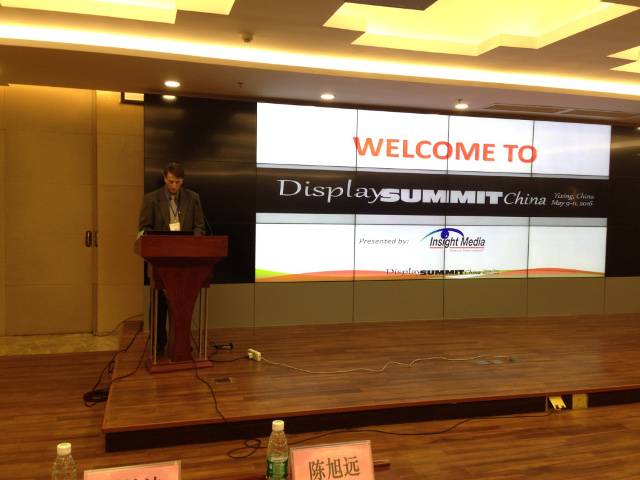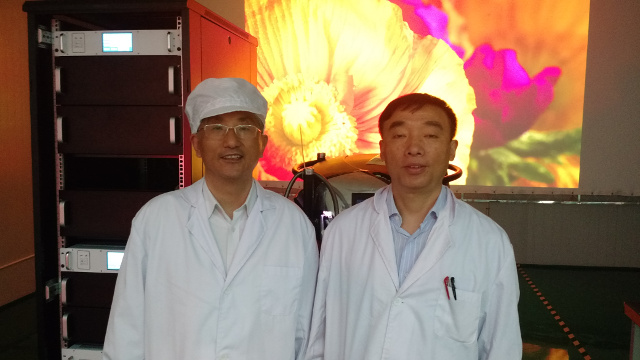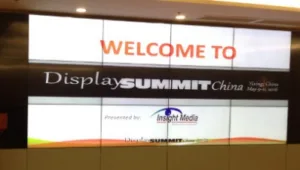The Insight Media produced event, Display Summit China, has just concluded here in Yixing, China. I can’t speak for what the Chinese participants took away from the event, but I had some clear expected and not-expected take aways that I want to share below.

 Compound Photonics used the event to publicly describe for the first time some of the technologies and products they are working on. The company told us when we visited their Phoenix facility in March, the company is working to introduce a 4K RGB laser projector with 3000 lumens for the corporate market at price points that will be very attractive. The company is not only building its own projector, but it makes its own LCOS panels and laser solution. They believe its 4K panel is the smallest yet at only 0.55”.
Compound Photonics used the event to publicly describe for the first time some of the technologies and products they are working on. The company told us when we visited their Phoenix facility in March, the company is working to introduce a 4K RGB laser projector with 3000 lumens for the corporate market at price points that will be very attractive. The company is not only building its own projector, but it makes its own LCOS panels and laser solution. They believe its 4K panel is the smallest yet at only 0.55”.- Philips Lighting talked about their new ColorSpark green LED light source that is enabling LED projectors to reach 3500 lumens soon. But they surprised attendees by describing a new yellow source that will be coupled to 3LCD projectors, although demonstrations of the technology will not be available until later in 2016.
- Laser phosphor technology is also becoming widespread as well, with projectors from Appotronics, Inovel, Seemile, Hisense and others on display. Hisense, the number three TV maker worldwide, seems to be all–in on laser phosphor and announced at the event that it plans to offer a new 4K laser TV in June. Apparently this will use the new 2 million mirror 4K DLP chip with an image shifter and a laser phosphor source. This will be followed later with what they call a ‘dual color’ version that uses blue and red lasers to augment the colors in these channels. Such a major company targeting the laser TV market speaks volumes about how many Chinese companies see the potential of laser phosphor and RGB laser projection in China
- Inovel showed a very nice short throw laser phosphor projector, the V8 model, that retails for CNY40,000 (~$7,000), but they said the price is too high and needs to be about half this value to open up the market.
- RGB laser technology in China is also advancing. Nanjing CQ Laser and JM Lasertec described solutions aimed at cinema applications and home theaters, but there are others developing solutions too. JM Lasertech said they have deployed their RGB laser solution in 53 cinemas screens in China already.

- There was clear disagreement about the role of laser phosphor vs. RGB laser in the cinema market. As we reported from NAB, Christie thinks that by 2022, all new cinema projectors will be RGB laser products. Barco disagrees, seeing a good future for laser phosphor solutions. There was much debate about the dominance and timing of RGB laser in cinema, but one thing was clear however – there is a lack of knowledge about the true costs of RGB laser solutions in the industry. This means not only the cost of the lasers, but the thermal management, speckle reduction, optical coupling and other issues associated with creating a solution.
- Barco, RealD and Dolby all described aspects of advancements in the digital cinema space where their leadership has been instrumental, including RGB laser projectors, advanced screen technology, wide color gamut and high dynamic range. Sim2 later described their two-projector HDR home theater projector, which is available now. Afterwards, we asked for a show of hands from those who had seen a high dynamic range projector or flat panel solution. Only a half-dozen hands were raised among the 90+ attendees, indicating a huge gap in knowledge and experience with this technology in China.
- The JBMIA, a Japanese trade association, described how they helped to get IEC standards issued that designate laser-illuminated projectors based upon their “risk group” category. Risk group two effectively allows laser illuminated projectors up to about 10,000 lumens to be treated like lamp-based projectors, with more careful restrictions on safety above this level. Unfortunately, the FDA in the US, which regulates such devices, has not adopted the IEC standard and still maintains the need for a variance for installations of laser projectors in cinema. While the Laser Industry Projection Association (LIPA) is optimistic they can get a new ruling from the FDA to adopt the IEC standards, the timing remains uncertain. As a result, the rollout of planned RGB laser cinemas and non-cinema applications in the US may be adversely affected.
- With the emergence of RGB laser solutions, both Compound Photonics and DNP agreed that it is time to reconsider spectrally-selective screen materials to create high contrast, light rejecting screens that can take advantage of the narrow primaries with an RGB laser projector. Sony and DNP developed such screens a number of years ago, but the timing was too early, so it is time to revisit those designs.
This first-year event seemed to be well received by attendees as there was lots of discussion and questions after the high-quality presentations with additional time to see the exhibits and network with new and old colleagues. There was even time for all to visit three local display manufacturing companies and tour their facilities.
These are a few of the key observations, with more detailed coverage to follow in the subscription newsletter, Large Display Monitor. – Chris Chinnock

